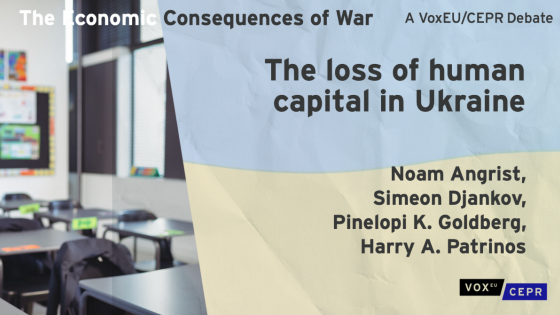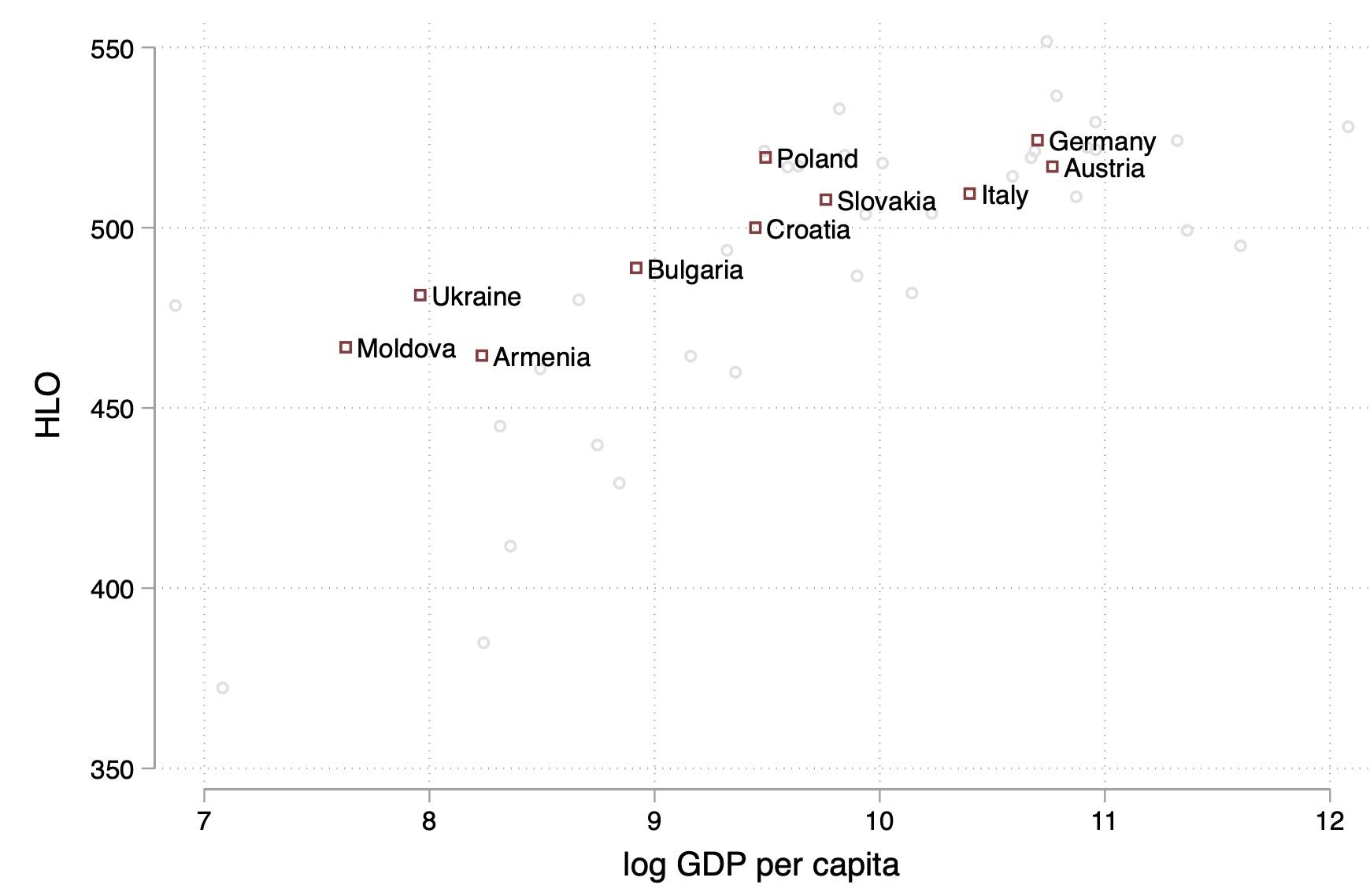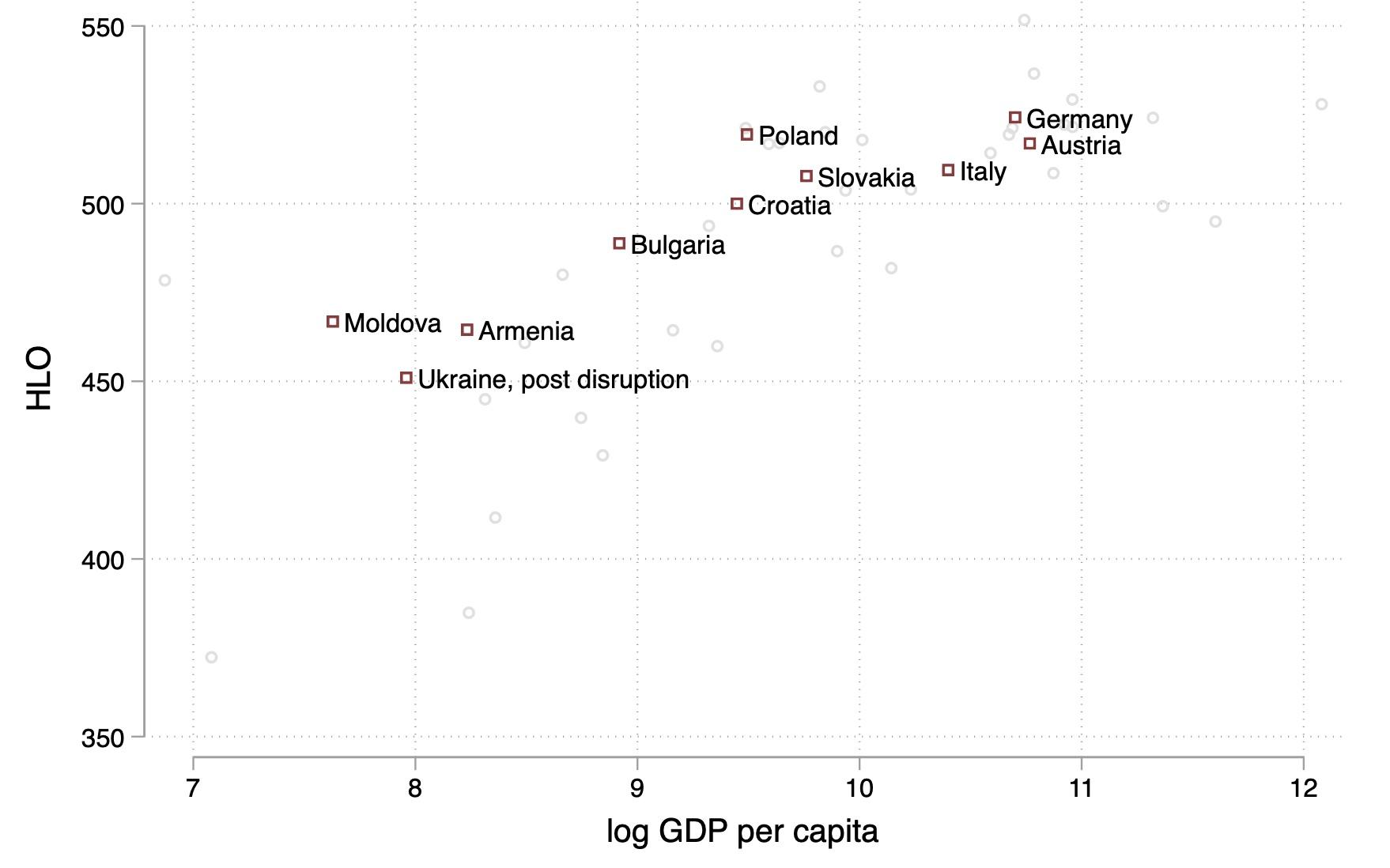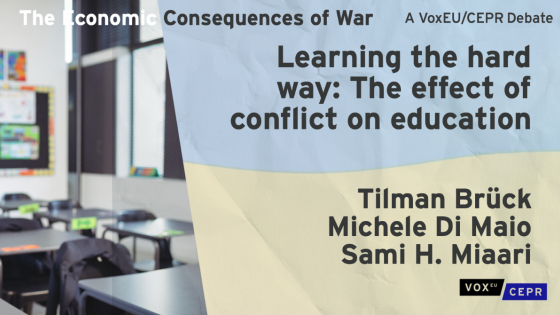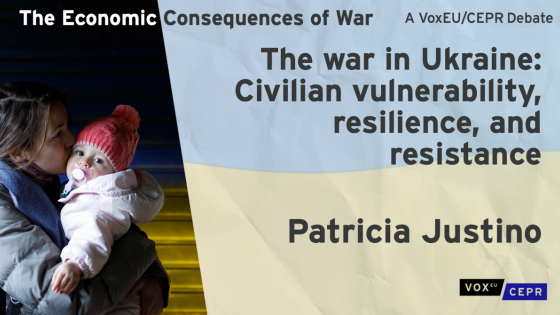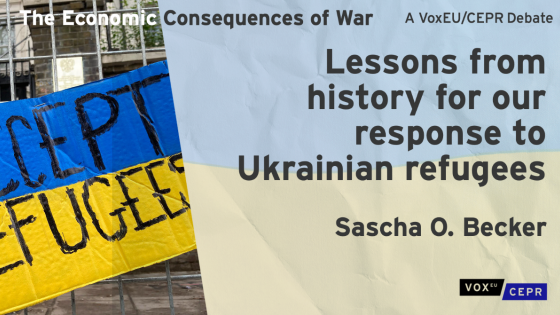Editors' note: This column is part of the Vox debate on the economic consequences of war.
Studies on war or civil conflicts can be used to gauge the human capital losses from the Russian invasion in Ukraine. Ichino and Winter-Ebmer (2004) find that Austrian and German children who were ten years old during WWII, or were involved in the war through their parents, received less education than comparable individuals from non-war countries such as Switzerland and Sweden. These individuals experienced a sizable earnings loss of between 3% and 4% a year some 40 years after the war, which can be attributed to the educational loss caused by the conflict. Using data on learning in the former Yugoslavia, Lai and Thyne (2007) and Eder (2014) argue that children born into or growing up in conflict become permanently less productive.
Even smaller disruptions to schooling than wars have large negative effects on learning. The effect may differ between girls and boys. Girls who were of school age during the 1992-98 Tajik civil war and lived in affected regions were less likely to complete their mandatory schooling than girls of the same age who lived in the regions relatively unaffected by conflict (Shemyakina 2011). A study on the effects of the Ebola crisis in Sierra Leone shows that girls experience a persistent 16 percentage points drop in school enrolment post-crisis (Bandiera et al. 2019). As another example, in 2005 a large earthquake struck northern Pakistan. Four years later, children under the age of three at the time of the earthquake had accumulated large height deficits and children aged 3–11 scored significantly worse on academic tests (Andrabi et al. 2021).
The Covid-19 pandemic created a worldwide disruption that can be used to measure the effect of school closures on learning. One study comes from the Netherlands, which features an equitable system of school funding as well as the world’s highest rate of broadband access and as a result underwent only a short lockdown (eight weeks). Still, Engzell et al. (2021) reveal a learning loss of about three percentile points. The effect is equivalent to one-fifth of a school year, the same period that schools remained closed. Losses are up to 60% larger among students from less-educated homes, confirming worries about the uneven toll of the pandemic on children and families.
Estimates from other school disruptions due to Covid-19, show that on average, losses in Europe have amounted to about one-third of a year’s worth of learning (Donnelly and Patrinos 2021). In countries with longer closure periods, such as Poland, learning losses imply a loss of the equivalent of a year in school (Jakubowski et al. 2022).
Learning losses in Ukraine
We estimate the learning losses due to the Russian invasion of Ukraine. Data from the Harmonized Learning Outcomes database (Angrist et al. 2021), recently published in Nature, show that Ukraine performs at par with its regional neighbours in eastern Europe, including Bulgaria and Croatia, prior to the Covid-19 pandemic and the Russian invasion (Figure 1).
Figure 1 Ukraine performed at par with its peers on learning in 2019
Source: Estimates using data from Angrist et al. (2021).
Continued school closures only exacerbate learning losses in Ukraine. Schools were closed or disrupted due to Covid-19 for 31 weeks in Ukraine, or about 7.75 months. The learning loss associated with school closures of this length are estimated to be around 20 points, based on OECD averages of learning per year. We add another two months due to the war to-date. Many Ukrainian children will take a lot longer to come back to the classroom. The war in Ukraine has resulted in more than 5.2 million Ukrainians fleeing to neighbouring countries.1 The refugees include primarily children, women, and older people, as all men below the age of 60 have been conscripted in the army. The number of internally displaced persons – those who have been forced from their homes but are still in Ukraine – exceed seven million. These children will likely not go back to school before the fall, losing at least five additional months of school time.
This simple calculation suggests that learning losses in Ukraine can amount to over one year, due to a combination of extended pandemic-related closures and the war. Estimates of harmonized Learning Outcomes due to this length of school closure could fall from 481 to about 451 points, below the lowest performing countries in Europe, Moldova, and Armenia (Figure 2). The long-term effect could be substantial, with future earnings losses of more than 10% a year per student.
Figure 2 Estimates of Ukraine learning levels post Covid-19 and war-related school disruptions
Source: Estimates using data from Angrist et al. (2021).
Policy implications: Providing education for temporarily displaced children
The experience of Ukrainian children who have been displaced from their homes is hugely disruptive. The uncertainty of when and where their families will be reunited will surely delay any school decisions. While providing education during war is difficult, evidence suggests several policies that make it possible. First, opening classes for Ukrainian refugees in selected schools in neighbouring countries can be a temporary answer, as well as expanding schools in parts of Ukraine where many internally displaced families have moved.
Second, online, by-phone, or in-person tutoring can happen anywhere and bring positive results. During Covid-19 school closures, online tutoring provided by university volunteers for secondary school students proved effective in Italy, with increases in learning of 0.26 standard deviations (Carlana and La Ferrara 2021) and a unit cost of €50; similar positive results for an online experiment were found in the case of online tutoring in Spain (Gortazar et al. 2022) and a cost-effective online tutoring program in the US was recently evaluated (Kraft et al. 2022).
In settings with limited internet access during school disruption, phone call tutorials were highly cost-effective with up to a full year of high-quality instruction gained per $100 spent (Angrist et al. 2020a). This approach has been tested in multiple countries with similarly large and cost-effective learning gains. In some neighbouring countries like Poland, in-person tutoring can also be organised. This effort would be complementary to the online education system that Ukraine has just launched: the All-Ukrainian Online School platform.
Third, adapting curricula – including printing textbooks in Ukrainian – in countries receiving refugees so that a large number of refugee children can regain access to standard schooling is a way forward. Such progress is already being made in Hungary and Poland, while Bulgaria is falling behind. This step suggests a longer-term stay of Ukrainian families abroad, at least for families from the worst-affected regions.
Some of these policies and interventions have effects on par with the most cost-effective and largest gains in the education literature (Angrist et al. 2020b), likely since the counterfactual is so dire. Education provision during war is daunting yet finding a way to provide educational instruction is possible and stems human capital losses which would otherwise compound long after the war.
References
Andrabi, T, B Daniels and J Das (2021), “Human Capital Accumulation and Disasters: Evidence from the Pakistan Earthquake of 2005”, Journal of Human Resources 56(6): 243-278.
Angrist, N, S Djankov, P Goldberg and H A Patrinos (2021), "Measuring human capital using global learning data", Nature 592(7854): 403-408.
Angrist, N, P Bergman and M Matsheng (2020a), “School’s out: Experimental evidence on limiting learning loss using ‘low-tech’ in a pandemic”, NBER Working Paper w28205.
Angrist, N, D Evans, D Filmer, R Glennerster, H Rogers and S Sabarwal (2020b), “How to improve education outcomes most efficiently? A Comparison of 150 interventions using the new Learning-Adjusted Years of Schooling metric”, London School of Economics, mimeo.
Bandiera, O, N Buehren, M Goldstein, I Rasul and A Smurra (2019), “The economic lives of young women in the time of ebola: lessons from an empowerment program”, London School of Economics, mimeo.
Becker, S (2022), “Lessons from history for our response to Ukrainian refugees”, VoxEU.org, 29 March.
Carlana, M and E La Ferrara (2021), “Apart but connected: Online tutoring and student outcomes during the COVID-19 pandemic”, London School of Economics, mimeo.
Donnelly, R and H Patrinos (2021), “Learning loss during COVID-19: An early systematic review”, Prospects (17): 1-9.
Eder, C (2014), “Displacement and Education of the Next Generation: Evidence from Bosnia and Herzegovina”, IZA Journal of Labor & Development 3(1): 1–24.
Engzell, P, A Frey and M Verhagen (2021), “Learning loss due to school closures during the COVID-19 pandemic”, PNAS 118(17): 376-418.
Gortazar, L, C Hupkau and A Roldan (2022), “Online tutoring works: Experimental evidence from a program with vulnerable children”, ESADE Center for Economic Policy and School of Public Policy, Spain, Working Paper No. 2.
Ichino, A and R Winter-Ebmer (2004), “The Long-run Educational Cost of World War II”, Journal of Labor Economics 22(1): 57–87.
Justino, P (2022), “The war in Ukraine: Civilian vulnerability, resilience, and resistance”, VoxEU.org, 14 April.
Kraft, M, J List, J Livingston and S Sadoff (2022), “Online Tutoring by College Volunteers: Experimental Evidence from a Pilot Program”, American Economic Review: Papers & Proceedings, forthcoming.
Lai, B and C Thyne (2007), “The Effect of Civil War on Education, 1980—97”, Journal of Peace Research 44(3): 277–292.
Shemyakina, O (2011), “The effect of armed conflict on accumulation of schooling: Results from Tajikistan”, Journal of Development Economics 95(2): 186-200.
Endnotes
1 https://data2.unhcr.org/en/situations/ukraine
